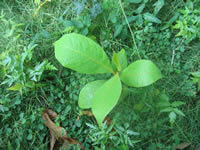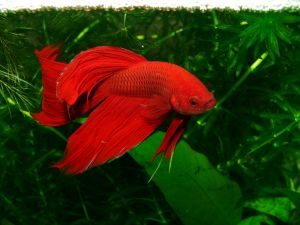Introduction

Indian almond seedling
Indian almond leaves (IAL) have traditionally been used by South East Asian Betta breeders to mimic the natural Betta habitat in captivity and make their fish stronger, healthier and more reproductive. Indian almond leaves are also believed to help fighting fish get in prime shape before a battle and heal their wounds afterwards.
As far as I know, the effect of Indian almond leaves on Betta fish has not been scientifically studied and it can therefore be hard to separate truth from myth when discussing IAL and Bettas. I can only speak from personal experience with Indian almond leaves in Betta tanks and relay anecdotal evidence from fellow Betta keepers. Hopefully, the field will be more thoroughly investigated in the future.
Even if you only plan on using Indian almond leaves in your Betta tanks I suggest you read this using Indian almond leaves in aquariums article since it contains a lot of general advice pertaining to IAL in fish tanks, e.g. why you shouldn’t use IAL together with activated carbon.
Using Indian almond leaves in Betta tanks
Some Betta keepers and breeder use Indian almond leaves all the time, while others prefer to use them in certain situations only. This can for instance be when….
- … you want to coax your Bettas into spawning
- … your Betta seem to be a bit under the weather and needs some pampering
- … your Betta has been injured
- … you are introducing a Betta to a new home
- … your are setting up a new Betta tank
- … you are shipping a Betta
- … you are setting up a separate fry rearing tank and wants to condition the water and give the fry access to infusoria
If you use Indian almond leaves all the time, the safest course of action is to gradually wean your Betta off the stuff before selling it to an aquarist that won’t use IAL. A Betta raised in an IAL-tank (or even one that has spent a lot of time in such a tank) can have a hard time adjusting if suddenly tossed into a tank without Indian almond leaves. Make the process slow and gradual.
Preparations
- Store any unused leaves in a dry place at room temperature. Thoroughly dry leaves placed in a dark, airtight and watertight container at room temperature will normally be fine for at least 6 months.
- Discard any leaf that is mouldy.
- Give each leaf a good rinse in tap water before using it if the almond tree may have been subjected to pesticides or grows in a polluted environment, e.g. a big city with lots of cars.
- If you’re in a hurry, Indian almond leaves can be cut or shredded into smaller pieces to make them leach their content into the water more rapidly.
- If you have activated carbon, purigen or similar in your aquarium, remove it before using Indian almond leaves.
How much should I use for my Betta?
- Different Betta keepers have different opinions when it comes to the ideal dose, but using 2 leaves per 50 L (13 us gallons) is common. There are however quite a few keepers that routinely use 2 leaves per 15 L (4 us gallons) in their Betta tanks.
- In Betta breeding tanks, the standard dose is 1 leaf per 20 L (5 us gallons).
- In Betta fry rearing tanks, the standard dose is 1 leaf per 40 L (10 us gallons) of water.
These recommendations are based on 15-25 cm (6-10 in) leaves. If your leaves are larger or smaller, you need to adjust accordingly.
For how long?
- Indian almond leaves normally disintegrate after a month or two, depending on how interested your fish is in actively destroying them. Betta keepers that shun torn leaves normally replace the IAL every second or third week, but for aesthetical reasons only. If your don’t have a problem with seeing decaying leaves in your tank you don’t have to change them more frequently than every second month.
- Unless you attach the leaves to something, they will normally float at the surface for 2-3 days before sinking to the bottom. This is a perfectly natural process and you don’t have to replace the leaves just because they sink.
Traditional conditioning of Siamese Fighting Fish (Betta splendens)
In South East Asia, keepers of Siamese Fighting fish traditionally use Indian almond leaves to prepare their fish for a fight. The leaves are believed to make the skin and scales of the fish hard, smooth and slippery enough to handle being bitten by the adversary. Prior to a fight, the fish is placed in a clay pot filled with clean, aged water and Indian almond leaves. It stays in the pot for at least seven days before a fight and is feed live food once a day. The pot is normally kept in dark and calm place.
After a fight, the Betta is given more or less the same treatment while recovering from its battle wounds.

